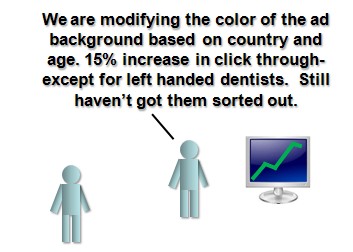« Twitter and Microsoft Business Intelligence- talk about tweet share | 6 Tips for making a business intelligence project budget »
The Datarati- Advertising discovers data ninjutsu
I discovered a new term that resonates with me. Datarati- when I heard it, I thought of people who love data, do their own analysis and act quickly and with confidence based on that analysis. I first came across this new word in an article on Googlenomics in Wired. The article quotes Hal Varian, Google’s chief economist;
Varian believes that a new era is dawning for what you might call the datarati—and it’s all about harnessing supply and demand. “What’s ubiquitous and cheap?” Varian asks. “Data.” And what is scarce? The analytic ability to utilize that data. As a result, he believes that the kind of technical person who once would have wound up working for a hedge fund on Wall Street will now work at a firm whose business hinges on making smart, daring choices—decisions based on surprising results gleaned from algorithmic spelunking and executed with the confidence that comes from really doing the math.
 A bit of googleing led me to the blog of Will Scully-Power, who lays claim to coining the term “datarati”. After a bit more surfing, its clear that there is buzz around the concept of data digging in the online advertising world, and particularly the new datarati that are driving it, and bringing the data analysis skills that are needed to the table.
A bit of googleing led me to the blog of Will Scully-Power, who lays claim to coining the term “datarati”. After a bit more surfing, its clear that there is buzz around the concept of data digging in the online advertising world, and particularly the new datarati that are driving it, and bringing the data analysis skills that are needed to the table.
In a recent article the New York Times reports;
Major advertising holding companies like WPP, the Publicis Groupe, Havas, MDC Partners and the Interpublic Group are starting data practices, hoping to latch onto what is expected to be the fastest-growing category of online advertising in the next five years.
What these new datarati know is that closed loops are the way to go- quickly gather data, analyze it, and make decisions and take actions that will affect the process. Repeat. Optimise. Move faster because you know you can adjust on the fly. Find entirely unexpected, unplanned success because you can move fast enough and try enough things that serendipity can work in your favor. Don’t brainstorm 500 ideas and then cut them down to just five that actually get implemented- do hundreds of them, SEE which ones take off, and iterate from there.
Consider the difference between online advertising and how television advertising used to work.
Television
- Spend millions on focus groups, testing and validation
- Book and commit to your ad space months in advance
- Spend millions on producing a fixed, can’t change it on the fly set of ads.
- Run the ads, and pay the television network the money with no ability to change regardless of effect- (except canceling them, thus losing your investment)
- Find out months later how effective they were (if you are lucky), but with only sketchy links between the ads, when they ran, and the demographics involved and any actual consumer purchases.
Online Advertising with the datarati at the helm
- Quickly come up with multiple- perhaps hundreds (using combinations along dimensions) of ideas and ads
- Put them online, tracking where, when, who, what
- Based on the actual real time click through, and online purchase results modify the ads, where they run, change your bids in real time auctions and optimize the ad campaign return literally minute by minute.
- Data mine the results to find patterns and identify new sub-groups of customers, test hypothesis with new targeted ads.
- Drop what’s not working, add new things, repeat, repeat repeat.
The datarati will have hundreds of iterations with real feedback from thousands of customers done before the old advertising model would have invited in the first fifty people for coffee, donuts and a focus group.
The famous “Half my advertising budget is wasted, I just don’t know which half.” has changed to a world where the datarati can know exactly what has to be cut, and how to optimize the rest, with granularity down into individual consumer/ad interactions.
It’s exactly this closed loop, large data volume, modify on the fly as needed data analysis that gets me excited, and is the whole concept behind the Datamartist tool. Datarati are people that are passionate about data- want to see it, touch it, and try things with it themselves, not content to wait for others to build something that may or may not still be needed.
The datarati point of view is “if you aren’t using data to make decisions, what ARE you using?”
The datarati are going to be using personal tools, they will be messing with their data themselves. Lets hope some of them find their way here, and give Datamartist a spin.
« Twitter and Microsoft Business Intelligence- talk about tweet share | 6 Tips for making a business intelligence project budget »



